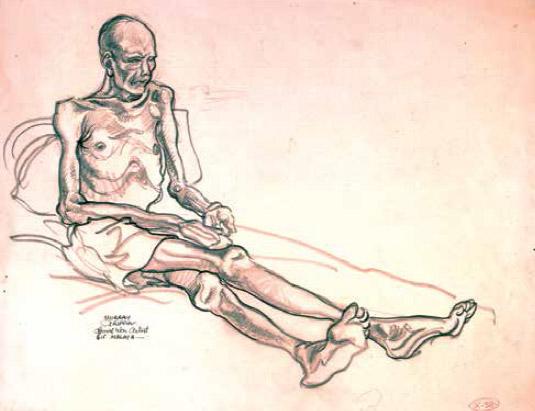Stolen Years: Australian prisoners of war - Murray Griffin: artist in Changi
My drawings were done as simple recordings of facts. Here I believe that an artist can, by what he leaves out, point very directly and convincingly to an activity. His mind acts as a sieve, forbidding the irrelevant.
Murray Griffin was appointed an official war artist in October 1941 and immediately went to Singapore. He was among the Australians captured when Singapore fell to the Japanese in February 1942, and remained a prisoner in Changi until liberation in August 1945.
Griffin’s paintings and drawings are one of the most sustained visual records of life as a prisoner. The earliest works depict prisoners learning to cope with the conditions of captivity. Later works reveal a growing emotional detachment. He became less a maker of art than a “recording instrument”, documenting the privations and achievements of his fellow prisoners.
I started to paint the life around me. Men showering under the eaves of buildings in rain – it was fresher water than in the tongs. Men doing chores, men dragging trailers loaded with camp necessities, men doing the hundred and one things prison camp required.
Murray Griffin
Second World War, official war artist
Changi prison camp, early days
oil over pencil on hardboard
painted in Changi, Singapore, in 1942
acquired under official war art scheme in 1946

Murray Griffin
Second World War, official war artist
POW just returned from Burma
pencil on paper
drawn in Changi, Singapore, in 1943
acquired under official war art scheme in 1946
ART26524
“It would be terrible if we who knew the horrors that modern warfare brought … did not record them.”
When the first survivors of the Burma–Thailand Railway returned to Changi at the end of 1943, Griffin was shocked by their diseased and emaciated condition, and his work became increasingly pessimistic.
Murray Griffin
Second World War, official war artist
Back from Thailand
pencil on paper
drawn in Changi, Singapore, in 1943
acquired under official war art scheme in 1946
“A recital of all the inventions and improvisations would become wearisome; it is hoped that the pictures will show something of the range of activities.”
Griffin later turned to depicting the inventions and improvised machinery in the camp. In these drawings Griffin concentrates on the technical ingenuity of the machines, while the figures become anonymous outlines lacking personality.
Murray Griffin
Second World War, official war artist
Cutting boot repair nails
brush and brown ink and wash heightened with white over pencil on paper
drawn in Changi, Singapore, in 1944
acquired under official war art scheme in 1946
Murray Griffin
Second World War, official war artist
Spinning thread from hemp twine
brush and brown ink and wash with pen and blue ink heightened with white on paper
drawn in Changi, Singapore, in 1944
acquired under official war art scheme in 1946
In the last year of his captivity, Griffin increasingly made drawings of religious or spiritual subjects, such as the various chapels, graveyards and funerals. But even here, while his figures are physically close, they are withdrawn and emotionally distant from one another.
Murray Griffin
Second World War, official war artist
St Andrew’s chapel
pen and ink and wash over pencil on paper
drawn in Changi, Singapore, in 1945
acquired under official war art scheme in 1946




